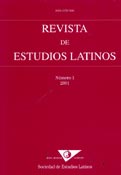Esquemas descendentes: a propósito de algunas aplicaciones del preverbio de- en el léxico mágico-religioso latino
DOI:
https://doi.org/10.23808/rel.v6i0.87892Palabras clave:
léxico técnico mágico-religioso; preverbio de-; connotación.Resumen
El presente trabajo ofrece el tratamiento conjunto de un grupo de verbos (deuouere, deprecari, detestari, deuocare, etc.), pertenecientes en mayor o menor medida al léxico técnico de la religión y la magia, con la intención de dar explicación a los valores connotativos adicionales que desarrolla el preverbio de- en dicha parcela de vocabulario latino.
Descargas
Descargas
Publicado
Cómo citar
Número
Sección
Licencia
Derechos de autor 2006 Revista de Estudios Latinos

Esta obra está bajo una licencia internacional Creative Commons Atribución-NoComercial-SinDerivadas 4.0.
Los originales publicados en las ediciones impresa y electrónica de esta revista son propiedad de las personas autoras de los mismos y se podrán difundir y transmitir siempre que se identifique la fuente original y la autoría en cualquier reproducción total o parcial de los mismos, y siempre que no tengan una finalidad comercial.






